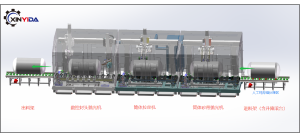What types of cylinders can it grind?
Diameter range: 600mm–1400mm
Effective polishing length: ≤2500mm
Workpiece weight: ≤1000kg
Grinding requirements: Polishing of circumferential welds, cylinder body, and end caps via production line
Surface roughness: ≤Ra0.8μm (spiral marks not allowed)
Cycle time: 10–13 minutes per unit (based on cylinder size for acceptance)
What are the components and steps of the grinding system?
Cylinder Belt Polishing Machine → Cylinder Brushing Machine → CNC End Cap Polishing Machine
Feeding Rack: Used to place the LNG cylinders to be ground (single station), equipped with a lifting roller table mechanism; weld seams are manually aligned and processed
Cylinder Belt Grinding: Performed by the cylinder belt polishing machine (2 grinding heads + 1 travel mechanism)
Cylinder Brushing: Performed by the cylinder brushing machine (2 grinding heads + 1 travel mechanism) using brushing wheels
End Cap Polishing: Performed by the CNC end cap polishing machine (2 rotary grinding heads + 2 travel mechanisms)
Discharge Rack: Used to output the finished LNG cylinders (single station)

What are the polishing process steps?
-
The cylinder is placed on the feeding rack, and “roller mode” is selected. The lifting roller table rises and drives the cylinder to rotate. At this point, the operator manually grinds the circumferential weld. Once completed, the “workpiece conveying” is activated, the roller lowers, and the cylinder is horizontally conveyed into the production line
-
The cylinder belt polishing machine receives the workpiece via its “conveying mechanism,” which then lowers. The cylinder is rotated by the roller stand while two abrasive belt grinding heads polish the cylinder body simultaneously. After polishing, the “conveying mechanism” lifts the workpiece and transports it to the next station
-
The cylinder brushing machine receives the workpiece via its “conveying mechanism,” which then lowers. The cylinder is rotated by the roller stand while two wide brushing wheel heads polish the cylinder simultaneously. After completion, the “conveying mechanism” lifts the workpiece and sends it to the next process
-
The end cap polishing machine receives the workpiece via its “conveying mechanism,” which then lowers. The cylinder is rotated by the roller stand while two sets of 3-axis polishing heads simultaneously polish the front and rear end caps. After polishing, the “conveying mechanism” lifts the workpiece and sends it to the discharge rack, completing the polishing process
Note: The grinding method involves moving polishing heads, with the cylinder rotating along its horizontal axis
The conveying rollers in each “conveying mechanism” operate in the same horizontal support and transport manner as the feeding and discharge racks
